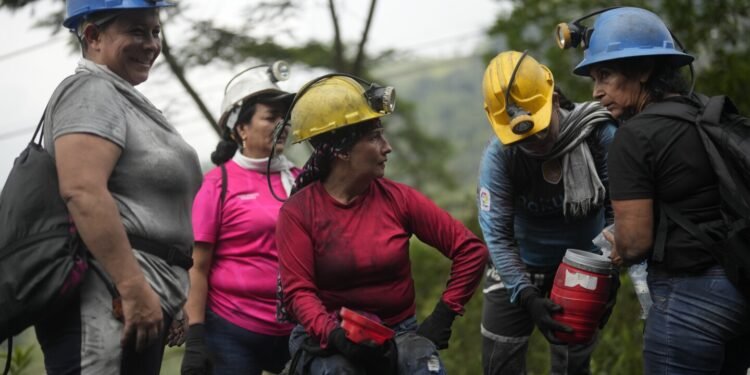COSCUEZ, Colombia (news agencies) — Deep inside mountain tunnels where the heat is so intense it causes headaches, women with power tools are chipping away at boulders in search of gems. They have opened a difficult path for themselves in Colombia’s emerald industry, a sector long dominated by men.
The lack of job opportunities, combined with the hope of a find that will make them rich, has pushed the women into mining. Colombian emeralds are known around the world for their quality and the best can be sold for thousands of dollars, though most people in the industry aren’t wealthy.
“There are months or years in which I don’t even make $250” from the emerald mines, said Yaneth Forero, one of the women at a small, informal mine near the town of Coscuez, where production has long been centered.
“But we continue to struggle here for the dream of having a home with tiles on the floors, a place that smells good and where no one can kick me out,” she said. She lives in a precarious hillside house where the walls are unpainted and the floor is made of cement.
Some of the biggest emeralds in the world have been mined in Colombia, including one weighing 3 pounds (1.36 kilograms) that broke the world record in 1995. In Coscuez, rumors circulate that one miner recently found an emerald that sold for $177,000, and left the ramshackle town forever.
In 2022, Colombian emerald exports were worth $122 million, according to the national federation of emerald companies. The gems are one of the nation’s most iconic products, and are sold in jewelry shops in cities like Cartagena and Bogotá.
But most emerald profits go to merchants and large companies that have invested millions of dollars in technologies that help them find the most valuable stones.
Workers at small, unregulated mines like Forero, who still use dynamite sticks to open tunnels, have a slim chance of finding the emeralds that can change someone’s destiny.
In her home outside Coscuez, Forero keeps some small, opaque emeralds that she has gathered over the past three months. She reckons that they are not worth more than $76 in all.
Her earnings are not enough to maintain her four children or help her father, who has developed a respiratory illness after working in emerald mines for decades and needs an oxygen tank to breathe.
So she also works random jobs to make ends meet like washing uniforms, ironing clothes and cleaning homes.
The 52-year-old said she has struggled to leave this way of life because the economy in Coscuez revolves around mining, and there are few other opportunities.
Working in the mines is tougher for women. Once they are done drilling in deep tunnels and sifting through rocks, they must care for their children and do domestic tasks that men are often reluctant to do.
Flor Marina Morales said she started to work in the mines around Coscuez because she needed to provide for her kids.
She said she used to arrive home from the mines at 3 a.m. and stay awake to make breakfast for her children and send them to school.
Morales’ children are now in university studying psychology and law.
“I’m glad they have a different outlook,” she said. “Mining is exhausting, and in this job you put up with a lot of hunger, cold and lack of sleep.”
To enter the small mines around Coscuez, women wear rubber boots and helmets and carry drills just like the men.
After they enter in a single file, they branch off in different directions and head into tunnels where each person has a designated area to drill. The rocks that break off the walls are carried outside in carts, washed and sifted through.
This kind of involvement by women was unthinkable a few decades ago in Colombia. Older villagers said that men previously barred women from approaching the mines because they believed that if women were around, the emeralds would hide.



 Pakistan Rupee Exchange Rate
Pakistan Rupee Exchange Rate





